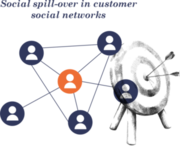Large businesses benefit by leveraging economies of scale. Typically, when a firm doubles its output, it will increase its input - but by less than double. This means that bigger companies can make bigger savings and profits. They also have greater bargaining power when it comes to suppliers and customers. So, to increase profitability, companies need to grow. “We wanted to understand more about how the path a company chooses to follow to achieve its growth can affect its performance,” says Professor Pierre Dussauge. “What are the benefits of rapid expansion through mergers and acquisitions compared to those associated with slow progressive and organic growth?”
Growth strategies impact operational efficiency and bargaining power
By looking at firm accounting data, Dussauge and his co-researchers found that the chosen path to big business has a significant effect on two factors: operational efficiency and bargaining power. Companies that grow through mergers and acquisitions gain an immediate advantage through increased bargaining power; whereas those that grow organically gradually gain greater operational efficiency. The researchers found that the benefits associated with mergers and acquisitions dissipate fast, whereas those that come through organic growth are longer lived.
Short-term gains from mergers and acquisitions
So, when companies merge or acquire to achieve growth, they gain bargaining power and their performance increases. However, this is often followed by a bandwagon effect where other companies follow suit, merging to level-off differences in bargaining power. Competitors soon start to request better deals from suppliers, who in turn may merge to fight back against the bargaining power of big buyers. This means that the advantage of improved bargaining power achieved through mergers and acquisitions can dissipate fairly rapidly. This form of growth also tends to cause organisational inefficiencies as the respective infrastructures of the combining companies come into conflict. Structural rearrangement and capital investment is needed to improve efficiency, and this takes time.
The researchers found that the benefits associated with mergers and acquisitions dissipate fast, whereas those that come through organic growth are longer lived.
Dussauge points to a recent acquisition in the car manufacturing sector to explain how this can play out: “PSA Peugeot-Citroën recently acquired Vauxhall-Opel. Together, the two companies will see huge initial benefits from their combined bargaining power. However, with manufacturing spread throughout different countries, their operational efficiency will suffer,” he says.
Playing the long game through organic growth
Conversely, companies that choose to grow progressively and organically tend to naturally evolve to be operationally efficient. However, they won’t have the same bargaining power as a newly merged firm and will keep having to renegotiate with suppliers to ensure they get the best deal. Going back to his car manufacturer example, Dussauge adds, “Volkswagen is a company that has (more-or-less) grown organically and benefits by operating from a well located set of plants. However, it does need to keep going back to the drawing board with suppliers to keep costs competitive.”
The benefits of scale come to those who act
The advantages of these two modes of company growth come naturally but so do their downsides. Dussauge notes, “Following a merger or acquisition, managers often report being disappointed with performance. The increased bargaining power they achieve is short lived, and organisational inefficiencies mean that profitability is lower than expected.” This disappointment occurs systematically. The study also found that companies that have grown organically often get a raw deal from suppliers that affects their profits. In both growth scenarios, companies fail to fully leverage their increased size. Dussauge stresses that companies need to be aware that there is a need for action following growth. To mitigate the downsides of their chosen growth paths, companies need to either reorganise or renegotiate.









